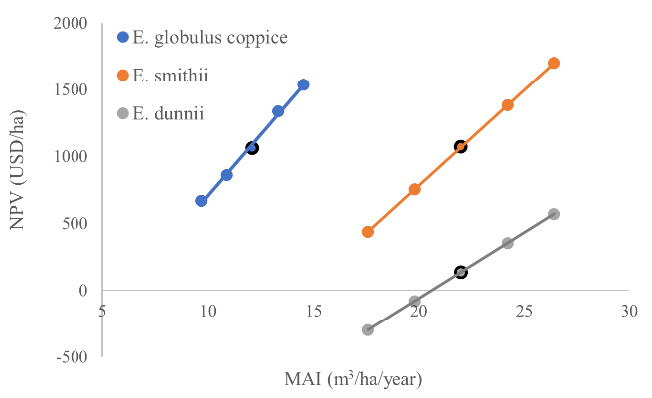Economic analysis of alternatives for second rotations in Eucalyptus globulus plantations in southeast Uruguay
DOI:
https://doi.org/10.31285/AGRO.27.976Keywords:
financial analysis, coppice, replantingAbstract
Eucalyptus globulus is one of the most planted forest species in Uruguay. However, its high susceptibility to diseases has determined that in recent years most plantations reaching harvest are replaced by other species, mainly E. dunnii and E. smithii. The decision whether to maintain the plantation for an additional rotation as coppice crop or to carry out a replanting depends on the expected economic results of both alternatives. Therefore, the objective of this research was to estimate the profitability of a coppice crop of E. globulus and that of a new plantation, with two different species, E. dunnii and E. smithii. In addition, a sensitivity analysis was carried out to study the impact of eventual variations in plantation productivity, in distance to the point of sale, and in the price of wood. Results showed that the three alternatives analyzed are economically viable, but that the management as coppice crop and the replanting with E. smithii are more profitable than replanting with E. dunnii. On the other hand, the coppice management is the alternative that requires less investment and that presents fewer risks, since it is less sensitive to changes in the main variables that determine the economic result.
Downloads
References
Balmelli G. Impacto de Mycosphaerella en Uruguay y variabilidad genética para resistencia a la enfermedad en Eucalyptus globulus y Eucalyptus maidenii [doctoral’s thesis]. Valladolid (ES): Universidad de Valladolid, Escuela Técnica Superior De Ingenierías Agrarias; 2014. 136p.
Bettinger P, Boston K, Siry JP, Grebner DL. Valuing and characterizing forest conditions. In: Forest management and planning. 2nd ed. New York: Academic Press; 2017. p. 21-64.
Crous JW, Burger L. A comparison of planting and coppice regeneration of Eucalyptus grandis × Eucalyptus urophylla clones in South Africa. South For. 2015;77(4):277-85.
Cubbage F, Kanieski B, Rubilar R, Bussoni A, Morales V, Balmelli G, Mac Donagh P, Lord R, Hernández C, Zhang P, Huang J, Korhonen J, Yao R, Hall P, De La Torre R, Balteiro L, Carrero O, Monges E, Thu HTT, Frey G, Howard M, Chavet M, Mochan S, Hoeflich V, Chudy R, Maas D, Chizmar D, Abt R. Global timber investments, 2005-2017. For Policy Econ. 2020;112:102802. Doi: 10.1016/j.forpol.2019.102082.
de Lima Guedes IC, Coelho Júnior LM, de Oliveira AD, de Mello JM, Pereira de Rezende JL, de Castro Silva CP. Análise econômica da reforma e da talhadia de povoamentos de eucalipto em condições de risco. Cerne. 2011;17(3):393-401.
Doldán J, Fariña I, Tarigo F. Utilización de Eucalyptus spp. Alternativas de plantaciones uruguayas para pulpa Kraft. INNOTEC. 2008;(3):30-34.
Drake P, Mendham D, White D, Odgen G. A comparison of growth, photosynthetic capacity and water stress in Eucalyptus globulus coppice regrowth and seedlings during early development. Tree Physiol. 2009;(29):663-74.
Gasparri P. Modelo predictivo de sobrevivencia de cepas de Eucalyptus globulus y evaluación financiera para diferentes alternativas de manejo [master’s thesis]. Montevideo (UY): Universidad de la República, Facultad de Agronomía; 2020. 71p.
Hamilton L. Managing Eucalyptus coppice [Internet]. Nakawa: NFA; 2005 [cited 2023 Mar 21]. 4p. (Plantations Guidelines; 21). Available from: https://spgs.mwe.go.ug/sites/files/Managing%20Eucalyptus%20Coppice.pdf
Ministerio de Ganadería, Agricultura y Pesca, DGF (UY). Cartografía Forestal Nacional 2018. Montevideo: MGAP; 2018. 21p.
Ministerio de Ganadería, Agricultura y Pesca, DIEA (UY). Anuario Estadístico Agropecuario 2014 [Internet]. Montevideo: MGAP; 2014 [cited 2023 Mar 21]. Available from: http://www.mgap.gub.uy/Dieaanterior/Anuario2014/dieaAnuario2014-Digital01.pdf
Morales V, Ansuberro J, Pintos M, Pérez G. Panorama empresarial del sector forestal uruguayo productor de Eucalyptus globulus. Agrociencia (Uruguay). 2018;22(1):133-9.
Prado JA, Bañados JC, Bello DA. Antecedentes sobre la capacidad de retoñación de algunas especies de género Eucalyptus en Chile. Cienc Invest For. 1990;(4):183-90.
Schönau AP. Growth, yield and timber density of short rotation coppice stands of Eucalyptus grandis. South Afr For J. 1991;(156):12-22.
Toval G. Calidad de la madera de Eucalyptus globulus como materia prima para la industria pastero-papelera. Boletín informativo CIDEU. 2010;(8-9):5-14.
Uruguay XXI. Exportaciones por capítulo [Internet]. Montevideo: Uruguay XXI; 2020 [cited 2023 Mar 21]. Available from: https://www.uruguayxxi.gub.uy/es/centro-informacion/articulo/exportaciones-por-capitulos/.
Whittock SP, Apiolaza LA, Kelly CM, Potts BM. Genetic control of coppice and lignotuber development in Eucalyptus globulus. Aust J Bot. 2003;(51):57-67.
Whittock SP, Greaves BL, Apiolaza LA. A cash flow model to compare coppice and genetically improved seedling options for Eucalyptus globulus pulpwood plantations. For Ecol Manag. 2004;191(1-3):267-74.

Published
How to Cite
Issue
Section
License
Copyright (c) 2023 Agrociencia Uruguay

This work is licensed under a Creative Commons Attribution 4.0 International License.
| Article metrics | |
|---|---|
| Abstract views | |
| Galley vies | |
| PDF Views | |
| HTML views | |
| Other views | |

















